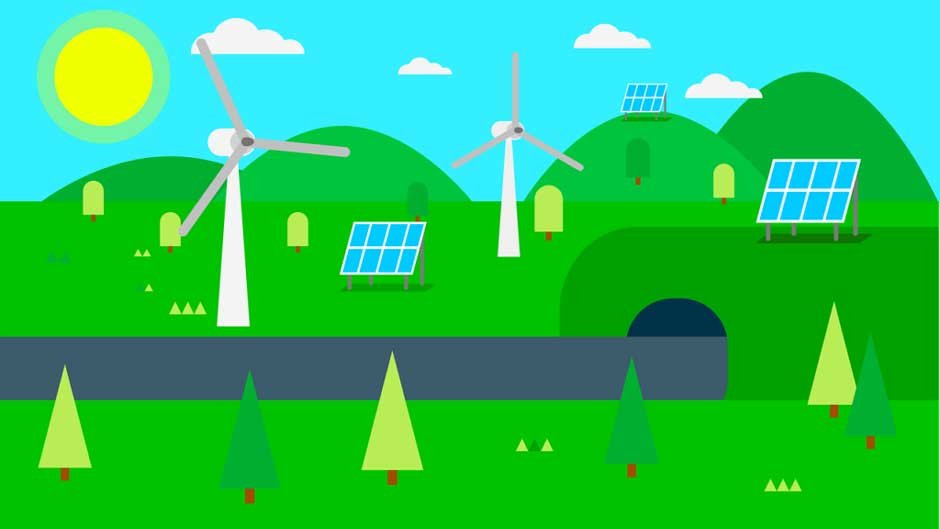Renewable energy sources offer an alternative to non-renewable fossil fuels to help reduce potential environmental impacts. There are several types of renewable energy sources, including solar energy, wind energy, hydropower, and geothermal energy. Solar energy is one power source that can be harnessed at home with help from a solar company. Here is more information about these four types of renewable energy sources and how they may be utilized:
1. Solar Energy
Sunlight is an abundant, sustainable renewable energy source. Solar panels harness sunlight via photovoltaic (PV) cells. These cells contain a semiconductor material, usually silicon. When sunlight hits the panel, it’s absorbed by the silicon. This absorption causes electrons to move, creating an electric current. Wires within the panel capture this current. It’s then converted into usable electricity. If you use solar power at home and are curious about how much you’re getting, power quality loggers can help.
Solar PV and solar thermal are two types of solar installations. PV systems use sunlight directly. They convert solar radiation into electricity using semiconductors. This type of system is typically used on homes and can be installed by a reliable solar company.
Solar thermal systems harness the sun’s heat by using mirrors or lenses to focus sunlight onto a small area. The concentrated heat warms a fluid, producing steam. This steam drives a turbine connected to an electricity generator.
2. Wind Energy
Wind turbines harness wind energy. The wind blows towards the turbine’s blades, causing them to spin. This spinning motion activates a generator within the turbine. The generator’s internal components convert this mechanical energy into electricity, which travels through cables to a transformer. The transformer adjusts the electricity’s voltage for safe transmission through power lines.
Wind energy can be generated from onshore and offshore wind farms. Onshore wind farms are located on land. They’re typically cheaper and easier to install. Offshore wind farms are found at sea. They capture stronger, more steady winds, increasing their energy production potential.
Wind energy offers a clean, abundant power source. It’s scalable to various sizes, locations, and energy demands. The conversion of wind’s kinetic energy into electrical energy involves no harmful emissions, making it an environmentally friendly process. Global wind patterns also provide consistent energy potential. This makes wind a reliable source of renewable energy. Individual turbines can be used to produce power for single homes.
3. Hydropower
Hydropower offers consistent, reliable energy with minimal emissions. It harnesses water’s kinetic energy, converting it into electricity. This happens at a hydropower plant. At the hydropower plant, water from reservoirs or rivers flows forcefully. This flow travels through a pipeline known as a penstock. The force spins a turbine connected to a generator which then converts the kinetic energy into electricity. Power lines transmit this electricity to consumers.
Dams, run-of-the-river, and pumped storage are the common hydropower systems. Dams store water in a reservoir. The water’s potential energy is converted into electricity. Run-of-the-river systems use a river’s natural flow. They generate electricity without disrupting the water flow. Pumped storage involves two water reservoirs at different heights. During off-peak hours, excess power pumps water to the higher reservoir. During peak demand, water flows to the lower reservoir, generating electricity.
4. Geothermal Energy
Geothermal power plants access Earth’s internal heat. They drill deep wells into geothermal reservoirs that contain hot water and steam. The plants pump the steam up to spin a turbine. This drives an electric generator to produce electricity. The plants cool the steam back into water and inject this water back into the Earth. This process maintains the geothermal resource to provide reliable, low-emissions power.
Geothermal systems come in three types: dry steam, flash steam, and binary cycle. Dry steam plants harness steam from underground reservoirs. Flash steam plants utilize hot, high-pressure water from reservoirs. The water turns to steam upon decreased pressure and generates electricity. Binary cycle plants use heat from hot water to convert a secondary fluid into steam. This steam then activates turbines for electricity production.
Embracing Renewable Energy With the Help of a Solar Company
Renewable energy sources like solar, wind, hydro, and geothermal can be used to benefit our environment and society. A solar company can provide the necessary expertise and equipment to harness the sun’s energy at your home, facilitating the transformation of sunlight into electricity. Contact an experienced solar company today for more information about solar panel installation.









